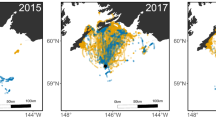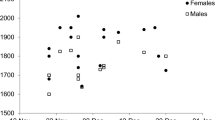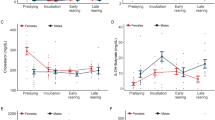Abstract
The evolution of longevity requires a low risk of mortality from extrinsic factors, relative to intrinsic factors, so that individuals that differentially invest in physiological self-maintenance and minimize their annual reproductive costs will maximize lifetime fitness through a prolonged reproductive lifespan. The trade-off between reproductive effort and self-maintenance, as measured by immune function, has been well documented in short-lived birds, but is difficult to demonstrate in long-lived birds. To assess self-maintenance in a long-lived seabird, we measured serum protein levels, including immunoglobulin G (IgG = IgY), in 30 breeding pairs of common terns (Sterna hirundo) and their first-hatched (A) chicks. Most parents were of known age from banding as hatchlings; our sample was selected to contrast young breeders (6–9 years) with very old birds (17–23 years). Body-mass of the parents declined by 5% during the chick-rearing period, while serum protein levels were stable. Serum IgG levels were higher in parents of offspring with faster growth rates, while IgG levels were lower in parents whose broods were reduced by starvation. A-chicks in broods of two had higher IgG levels than singleton chicks. Albumin levels were not related to reproductive performance. Thus, despite adequate statistical power, we could find no evidence for a trade-off between reproduction and self-maintenance in common terns, even in old age. The results are consistent with life-history predictions for long-lived vertebrates, in which selection favors sustained self-maintenance across the reproductive lifespan. The positive relationships between IgG levels and reproductive performance indicate that IgG can be used as an index of parental “quality.”



Similar content being viewed by others
References
Apanius V, Temple SA, Bale M (1983) Serum proteins of wild turkey vultures (Cathartes aura). Comp Biochem Physiol 76B:907–913
Apanius V (1998) Ontogeny of immune function. In: Starck JM, Ricklefs RE (eds) Avian growth and development: evolution within the altricial–precocial spectrum. Oxford University Press, Oxford, pp 203–222
Apanius V, Nisbet ICT (2003) Serum immunoglobulin G levels in very old common terns Sterna hirundo. Exp Gerontol 38:761–764
Arnold JM, Hatch JJ, Nisbet ICT (2004) Seasonal declines in reproductive success of the common tern: timing or parental quality? J Avian Biol 35:33–45
Barnard C, Behnke J, Sewell J (1994) Social behaviour and susceptibility to infection in house mice (Mus musculus): effects of group size, aggressive behaviour and status-related hormonal responses prior to infection on resistance to Babesia microti. Parasitology 108:487–496
Benner R, van Oudenaren A, Björklund M, Ivars F, Holmberg D (1982) ‘Background’ immunoglobulin production: measurement, biological significance and regulation. Immunol Today 3:243–249
Bollinger PB (1994) Relative effects of hatching order, egg-size variation, and parental quality on chick survival in common terns. Auk 111:263–273
Bond C, Gilbert P (1958) Comparative study of blood volume in representative aquatic and non-aquatic birds. Am J Physiol 194:519–521
Bridge E, Nisbet ICT (2004) Wing molt and assortative mating in common terns: a test of the molt-signaling hypothesis. Condor 106:336–343
Cam E, Link WA, Cooch EG, Monnat JY, Danchin E (2002) Individual covariation in life-history traits: seeing the trees despite the forest. Am Nat 159:96–105
Cam E, Monnat JY (2000) Stratification based on reproductive state reveals contrasting patterns of age-related variation in demographic parameters in the kittiwake. Oikos 90:560–574
Cichon M, Sendecka J, Gustafsson L (2003) Age-related decline in humoral immune function in collared flycatchers. J Evol Biol 16:1205–1210
Christe P, Møller AP, Saino N, de Lope F (2000) Genetic and environmental components of phenotypic variation in immune response and body size of a colonial bird (Delichon urbica) (the house martin). Heredity 85:75–83
Christe P, de Lope F, Gonzalez G, Saino N, Møller AP (2001) The influence of environmental conditions on immune responses, morphology and recapture probability of nestling house martins (Delichon urbica). Oecologia 126:333–338
Coulson JC, Thomas CS (1985) Differences in the breeding performance of individual kittiwake gulls (Rissa tridactyla). In: Sibly RM, Smith RH (eds) Behavioural ecology. Blackwell Scientific Publications, Oxford, pp 489–503
Deerenberg C, Apanius V, Daan S, Bos N (1997) Reproductive effort decreases antibody responsiveness. Proc R Soc Lond B 264:1021–1029
de Lope F, Møller AP, de la Cruz C (1998) Parasitism, immune response and reproductive success in the house martin Delichon urbica. Oecologia 114:188–193
DeVries AC, et al (1997) Stress affects corticosteroid and immunoglobulin concentrations in male house mice (Mus musculus) and prairie voles (Microtus ochrogaster). Comp Biochem Physiol A 118:655–663
Doumas B, Watson W, Biggs H (1971) Albumin standards and the measurement of serum albumin with bromcresol green. Clin Chim Acta 1:87–96
Dröge W (2002) Free radicals in the physiological control of cell function. Physiol Rev 82:47–95
Eising CM, Groothuis TGG (2003) Yolk androgens and begging behaviour in black-headed gull chicks: an experimental field study. Anim Behav 66:1027–1034
Fudge AM (2000) Avian blood sampling and artifact considerations. In: Fudge AM (ed) Laboratory medicine: avian and exotic pets. WB Saunders, Philadelphia, pp 1–8
Gustafsson L, Pärt T (1990) Acceleration of senescence in the collared flycatcher Ficedula albicollis by reproductive costs. Nature 347:279–281
Hamer KC, Schreiber E, Burger J (2002) Breeding biology, life histories and life history-environment interactions in seabirds. In: Schreiber EA, Burger J (eds) Biology of marine birds. CRC Press, Boca Raton, FL, pp 217–261
Hasselquist D, Marsh JA, Sherman PW, Wingfield JC (1999) Is avian humoral immunocompetence suppressed by testosterone? Behav Ecol Sociobiol 45:167–175
Holmes DJ, Ottinger MA (2003) Birds as long-lived animal models for the study of aging. Exp Gerontol 38:1365–1375
Hõrak P, Jenni ES, Ots I, Tegelmann L (1998) Health and reproduction: the sex-specific clinical profile of great tits (Parus major) in relation to breeding. Can J Zool 76:2235–2244
Kaneko J (1997) Serum proteins and the dysproteinemias. In: Kaneko J, Harvey J, Bruss M (eds) Clinical biochemistry of domestic animals, 5th edn. Academic Press, New York, pp 117–138
Kitaysky AS, Piatt JF, Wingfield JC (1999) The adrenocortical stress-response of black-legged kittiwakes chicks in relation to dietary restrictions. J Comp Physiol B 169:303–310
Kitaysky AS, Wingfield JC, Piatt JF (2001) Corticosterone facilitates begging and affects resource allocation in the black-legged kittiwake. Behav Ecol 12:619–625
Klasing K (1998) Comparative avian nutrition. CAB International, New York
Kowalczyk K, Daiss J, Halpern J, Roth TF (1985) Quantitation of maternal-fetal IgG transport in the chicken. Immunology 54:755–762
Kuhlmann-Rabens I, Wanke R, Storandt F, Altmann B, Losch U, Merkenschlager M (1987) Attempts to localize the defect in dysgammaglobulinemia of UM-B19 chickens by studying the effect of immunomodulating substances on immunoglobulin and antibody production. Vet Immunol Immunopathol 14:123–143
Lee K, Klasing K (2004) A role for immunology in invasion biology. Trends Ecol Evol 19:523–529
Lemke H, Coutinho A, Lange H (2004) Lamarckian inheritance of somatically acquired maternal IgG phenotypes. Trends Immunol 25:180–186
Leslie G, Clem L (1970) Chicken immunoglobulins: biological half-lives and normal adult serum concentrations of IgM and IgY. Proc Soc Exp Biol Med 134:195–198
Leveille G, Sauberlich H (1961) Influence of dietary protein level on serum protein components and cholesterol in the growing chick. J Nutr 74:500–504
Littell RC, Pendergast J, Natarajan R (2000) Modelling covariance structure in the analysis of repeated measures data. Stat Med 2000:1793–1819
Lung N, Thompson J, Kollias G, Olsen J, Zdziarski J, Klein P (1996) Maternal immunoglobulin G antibody transfer and development of immunoglobulin G antibody responses in blue and gold Macaw (Ara ararauna) chicks. Am J Vet Res 57:1162–1167
Mills JA (1989) Red-billed gull. In: Newton I (ed) Lifetime reproductive success. Academic Press, London, pp 387–404
Møller AP, de Lope F (1999) Senescence in a short-lived migratory bird: age-dependent morphology, migration, reproduction and parasitism. J Anim Ecol 68:163–171
Moreno J (2003) Lifetime reproductive success in seabirds: interindividual differences and implications for conservation. Sci Mar 67(Suppl. 2):7–12
Nisbet ICT (2001) Detecting and measuring senescence in wild birds: experience with long-lived seabirds. Exp Gerontol 36:833–843
Nisbet ICT (2002) Common tern (Sterna hirundo). In: Poole A, Gill F (eds) The birds of North America, No. 618. The Birds of North America Inc., Philadelphia
Nisbet ICT, Cam E (2002) Test for age-specificity in survival of the common tern. J Appl Stat 29:65–83
Nisbet ICT, Apanius V, Friar MS (2002a) Breeding performance of very old common terns. J Field Ornithol 73:117–124
Nisbet ICT, Finch CE, Thompson N, Russek-Cohen E, Proudman JA, Ottinger MA (1999) Endocrine patterns during aging in the common tern (Sterna hirundo). Gen Comp Endocrinol 114:279–286
Nisbet ICT, Montoya JP, Burger J, Hatch JJ (2002b) Use of stable isotopes to investigate individual differences in diets and mercury exposures among common terns Sterna hirundo in breeding and wintering grounds. Mar Ecol Prog Ser 242:267–274
Nordling D, Andersson M, Zohari S, Gustafsson L (1998) Reproductive effort reduces specific immune response and parasite resistance. Proc R Soc Lond B 265:1291–1298
Neuhoff V, Arold N, Taube D, Ehrhardt W (1988) Improved staining of proteins in polyacrylamide gels including isoelectric focusing gels with clear background at nanogram sensitivity using Coomassie Brilliant Blue G-250 and R-250. Electrophoresis 9:255–262
Nur N (1984a) The consequences of brood size for breeding blue tits I Adult survival, weight change and the cost of reproduction. J Anim Ecol 53:479–496
Nur N (1984b) The consequences of brood size for breeding blue tits II Nestling weight, offspring survival and optimal brood size. J Anim Ecol 53:497–517
O’Brien P, Aitken R (2002) Antibody phage display: methods and protocols. Humana Press, Totowa
Rees MJ, Nordskog AW (1981) Genetic control of serum immunoglobulin G levels in the chicken. J Immunogenet 8:425–431
Rehder NB, Bird DM, Lague PC (1982) Variations in blood packed cell volume of captive American kestrels. Comp Biochem Physiol 72A:105–109
Ricklefs RE (1992) The roles of parent and chick in determining feeding rates in Leach’s storm-petrel. Anim Behav 43:895–906
Ricklefs RE (2000) Intrinsic aging-related mortality in birds. J Avian Biol 31:103–111
Ros AFH, Groothuis TGG, Apanius V (1997) The relationship between gonadal steroids, immunocompetence, body mass, and behavior in young black-headed gulls (Larus ridibundus). Am Nat 150:201–219
Roskaft E (1985) The effect of enlarged brood size on the future reproductive potential of the rook. J Anim Ecol 54:255–260
Rowe D, McGregor I, Smith SJ (1968) Plasma immunoglobulin concentrations in a West African (Gambian) community and in a group of healthy British adults. Clin Exp Immunol 3:63–79
Sabbele N, van Oudenaren A, Benner R (1983) The effect of corticosteroids upon the number and organ distribution of ‘background’ immunoglobulin-secreting cells in mice. Cell Immunol 77:308–317
Sabiston B, Ste Rose J (1976) Effect of cold exposure on the metabolism of immunoglobulins in rabbits. J Immunol 116:106–111
Sæther BE, Andersen R, Pedersen HC (1993) Regulation of parental effort in a long-lived seabird—an experimental manipulation of the cost of reproduction in the Antarctic petrel, Thalassoica antarctica. Behav Ecol Sociobiol 33:147–150
Saino N, Bolzern AM, Møller AP (1997) Immunocompetence, ornamentation, and viability of male barn swallows (Hirundo rustica). Proc Nat Acad Sci U S A 94:549–552
Saino N, Martinelli R, Møller AP (2001a) Immunoglobulin plasma concentration in relation to egg laying and mate ornamentation of female barn swallows (Hirundo rustica). J Evol Biol 14:95–109
Saino N, Incagli M, Martinelli R, Ambrosini R, Møller AP (2001b) Immunity, growth and begging behaviour of nestling barn swallows Hirundo rustica in relation to hatching order. J Avian Biol 32:263–270
Saino N, Ambrosini R, Martinelli R, Møller AP (2002) Mate fidelity, senescence in breeding performance and reproductive trade-offs in the barn swallow. J Anim Ecol 71:309–319
Saino N, Ferrari RP, Romano M, Rubolini D, Møller AP (2003) Humoral immune response in relation to senescence, sex and sexual ornamentation in the barn swallow (Hirundo rustica). J Evol Biol 16:1127–1134
Sanz JJ, Moreno J (2000) Delayed senescence in a southern population of the pied flycatcher (Ficedula hypoleuca). Ecoscience 7:25–31
Sarker N, Tsudzuki M, Nishibori M, Yamamoto Y (1999) Direct and correlated response to divergent selection for serum immunoglobulin M and G levels in birds. Poult Sci 78:1–7
Sarker N, Tsudzuki M, Nishibori M, Yasue H, Yamamoto Y (2000) Cell-mediated and humoral immunity and phagocytic ability in chicken lines divergently selected for serum immunoglobulin M and G levels. Poult Sci 79:1705–1709
Sheldon BC, Verhulst S (1996) Ecological immunology, costly parasite defenses and trade-offs in evolutionary ecology. Trends Ecol Evol 11:317–321
Solomon JB (1970) Unification of foetal and neonatal immunology. Nature 227:895–897
Stearns SC (1992) The evolution of life histories. Oxford University Press, Oxford
Szep T, Møller AP (1999) Cost of parasitism and host immune defence in the sand martin (Riparia riparia): a role for parent-offspring conflict? Oecologia 119:9–15
Tims J, Nisbet ICT, Friar MS, Mostello C, Hatch JJ (2004) Characteristics and performance of common terns in old and newly-established colonies. Waterbirds 27:321–332
Waldmann T, Blaese R, Strober W (1970) Physiological factors controlling immunoglobulin metabolism. In: Rothschild M, Waldmann T (eds) Plasma protein metabolism: regulation of synthesis, distribution, and degradation. Academic Press, New York, pp 269–286
Warr GW, Magor KE, Higgins DA (1995) IgY: clues to the origins of modern antibodies. Immunol Today 16:392–398
Wendeln H, Becker PH (1996) Body mass change in breeding common terns Sterna hirundo. Bird Study 43:85–95
Williams GC (1966) Adaptation and natural selection. Princeton University Press, Princeton
Acknowledgments
We thank Suzanne Conlon, Margaret Friar, Tim Meehan, and Jeremy Hatch for help in the field in 1999, many other colleagues and assistants for banding chicks since 1976, and the Town of Marion for permission to work at Bird Island. Laboratory analyses were assisted by P. Scipio, Y. Sanchez, D. Rodriguez, and Y. Tran and supported by NIH-MBRS (GM61347). This research was approved by institutional, state, and federal agencies for compliance with animal welfare and migratory bird regulations.
Author information
Authors and Affiliations
Corresponding author
Additional information
Communicated by Carol Vleck
Rights and permissions
About this article
Cite this article
Apanius, V., Nisbet, I.C. Serum immunoglobulin G levels are positively related to reproductive performance in a long-lived seabird, the common tern (Sterna hirundo). Oecologia 147, 12–23 (2006). https://doi.org/10.1007/s00442-005-0238-6
Received:
Accepted:
Published:
Issue Date:
DOI: https://doi.org/10.1007/s00442-005-0238-6




